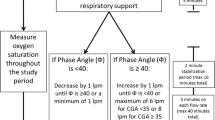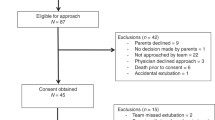Abstract
Objective:
The aim of this study was to measure pharyngeal pressures in preterm infants receiving high-flow nasal cannulae.
Study Design:
A total of 18 infants were studied (median gestational age 34 weeks, weight 1.619 kg). A catheter-tip pressure transducer was introduced into the nasopharynx. Flow was sequentially increased to a maximum of 8 l min−1 and decreased to a minimum of 2 l min−1.
Result:
There was a strong association between pharyngeal pressure and both flow rate and infant weight (P<0.001, r2=0.61), but not mouth closure. This relationship could be expressed as pharyngeal pressure (cm H2O)=0.7+1.1 F (F=flow per kg in l min−1 kg−1).
Conclusion:
High-flow nasal cannulae at flow rates of 2 to 8 l min−1 can lead to clinically significant elevations in pharyngeal pressure in preterm infants. Flow rate and weight but not mouth closure are important determinants of the pressure transmitted.
This is a preview of subscription content, access via your institution
Access options
Subscribe to this journal
Receive 12 print issues and online access
$259.00 per year
only $21.58 per issue
Buy this article
- Purchase on Springer Link
- Instant access to full article PDF
Prices may be subject to local taxes which are calculated during checkout



Similar content being viewed by others
References
Wilkinson D, Andersen C, O'Donnell C . High flow nasal cannula for respiratory support in preterm infants (protocol). Cochrane Database Syst Rev 2007; (1): CD006405. doi: 10.1002/14651858.CD06405
Locke RG, Wolfson MR, Shaffer TH, Rubenstein SD, Greenspan JS . Inadvertent administration of positive end-distending pressure during nasal cannula flow. Pediatrics 1993; 91(1): 135–138.
Sreenan C, Lemke RP, Hudson-Mason A, Osiovich H . High-flow nasal cannulae in the management of apnea of prematurity: a comparison with conventional nasal continuous positive airway pressure. Pediatrics 2001; 107(5): 1081–1083.
Shoemaker MT, Pierce MR, Yoder BA, Digeronimo RJ . High flow nasal cannula versus nasal CPAP for neonatal respiratory disease: a retrospective study. J Perinatol 2007; 27(2): 85–91.
Ramanathan A, Cayabyab R, Sardesai S, Siassi B, Istvan S, Ramanathan R . High flow nasal cannula use in preterm and term newborns admitted to neonatal intensive care unit: a prospective observational study (abstract). Pediatr Acad Soc 2005; 57: 3424.
Ovalle O, Gomez T, Troncoso G, Palacios J, Ortiz E . High flow nasal cannula after surfactant treatment for infant respiratory distress syndrome in preterm infants <30 weeks (abstract). Pediatr Acad Soc 2005; 57: 3417.
Woodhead DD, Lambert DK, Clark JM, Christensen RD . Comparing two methods of delivering high-flow gas therapy by nasal cannula following endotracheal extubation: a prospective, randomized, masked, crossover trial. J Perinatol 2006; 26: 481–485.
Campbell DM, Shah PS, Shah V, Kelly EN . Nasal continuous positive airway pressure from high flow cannula versus infant flow for preterm infants. J Perinatol 2006; 26: 546–549.
Saslow JG, Aghai ZH, Nakhla TA, Hart JJ, Lawrysh R, Stahl GE et al. Work of breathing using high-flow nasal cannula in preterm infants. J Perinatol 2006; 26: 476–480.
Chang G, Cox C, Shaffer T . Nasal cannula, CPAP and Vapotherm: effect of flow on temperature, humidity, pressure and resistance (abstract). Pediatr Acad Soc 2005; 57: 1231.
Finer NN . Nasal cannula use in the preterm infant: oxygen or pressure? Pediatrics 2005; 116(5): 1216–1217.
De Paoli AG, Lau R, Davis PG, Morley CJ . Pharyngeal pressure in preterm infants receiving nasal continuous positive airway pressure. Arch Dis Child Fetal Neonatal Ed 2005; 90(1): F79–F81.
Gappa M, Jackson E, Pilgrim L, Costeloe K, Stocks J . A new microtransducer catheter for measuring esophageal pressure in infants. Pediatr Pulmonol 1996; 22(2): 117–124.
Stell IM, Tompkins S, Lovell AT, Goldstone JC, Moxham J . An in vivo comparison of a catheter mounted pressure transducer system with conventional balloon catheters. Eur Respir J 1999; 13(5): 1158–1163.
Panizza JA, Finucane KE . Comparison of balloon and transducer catheters for estimating lung elasticity. J Appl Physiol 1992; 72(1): 231–235.
Akkermans LMA . Esophageal manometry: microtransducers. Dig Dis Sci 1991; 36(9): 14S–16S.
Reda M, Gibson GJ, Wilson JA . Pharyngoesophageal pressure monitoring in sleep apnea syndrome. Otolaryngol Head Neck Surg 2001; 125(4): 324–331.
Pedersen JE, Nielsen K . Oropharyngeal and esophageal pressure during mono- and binasal CPAP in neonates. Acta Paediatr 1994; 83(2): 143–149.
Greenough A, Morley CJ . Oesophageal pressure measurements in ventilated preterm babies. Arch Dis Child 1982; 57(11): 851–855.
Acknowledgements
We thank Peter Dwyer at the Mercy Hospital for Women for the loan of catheter-tip pressure transducers and associated equipment. Susan Donath and John Carlin at the Clinical Epidemiology and Biostatistics Unit, University of Melbourne provided expert statistical advice. Chris Wittwer and the other diligent staff at CSSD kindly helped with sterilization of catheters.
Financial Support: No extramural financial support was used for this study. The Medical Research Foundation for Women and Babies provided funding for the purchase of pressure transducers.
Author information
Authors and Affiliations
Corresponding author
Additional information
This study was undertaken in the neonatal unit, Mercy Hospital for Women.
Disclosure/Conflict of Interest
The authors do not have any duality of interests.
Appendix
Appendix
Alternative prediction model
Since regression residuals were found to increase with flow rate, a zero-skewness logarithmic transformation was applied to the outcome to provide an alternative prediction model with constant variance (Figure 4).
Predicted pharyngeal pressure (cm water)=e(2.1947+0.075303F−0.14711 wt)−6.2436.
Results using this model were similar to those obtained using the untransformed regression equation.
Rights and permissions
About this article
Cite this article
Wilkinson, D., Andersen, C., Smith, K. et al. Pharyngeal pressure with high-flow nasal cannulae in premature infants. J Perinatol 28, 42–47 (2008). https://doi.org/10.1038/sj.jp.7211879
Received:
Revised:
Accepted:
Published:
Issue Date:
DOI: https://doi.org/10.1038/sj.jp.7211879
Keywords
This article is cited by
-
Microbial signatures in amniotic fluid at preterm birth and association with bronchopulmonary dysplasia
Respiratory Research (2023)
-
Changes in the patterns of respiratory support and incidence of bronchopulmonary dysplasia; a single center experience
BMC Pediatrics (2023)
-
Weaning and extubation from neonatal mechanical ventilation: an evidenced-based review
BMC Pulmonary Medicine (2022)
-
Oral feeding for infants and children receiving nasal continuous positive airway pressure and high flow nasal cannula: a systematic review
BMC Pediatrics (2021)
-
Oral Feeding for Infants and Children Receiving Nasal Continuous Positive Airway Pressure and High-Flow Nasal Cannula Respiratory Supports: A Survey of Practice
Dysphagia (2020)




